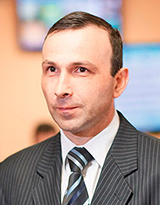ELECTRONICS, RADIOPHYSICS, RADIOENGINEERING, INFORMATICS
The article proposes two types of multibeam spherotron-diotron based on a two-spherical resonator (an early article suggested a spherotron-diotron with non-synchronous interaction on a bi-spherical resonator, where the electron beam in this generator passes along the resonator z axis from the outer sphere to the inner one and interacts with the longitudinal (axial) electric resonator field). The first spherotron type has electron beams going from outer to inner sphere with slope ϧ about the z-axis: ϧ=0, π/8, π/4. The electrons interact with the resonator field through the emergence of quadratic forces in the field increasing along the electron motion. The second type (inverted spherotron) has electron beams located in half arc of the equatorial resonator plane, and the electrons move from the inner sphere to the outside. The interaction in it is carried out due to the spatial electron phasing. Both spherotron types achieve efficiency of 30 % at ultra-high pulse power and tens of kuloampère of total beam currents. The data presented in the article indicate the prospects of broad application for the inverted spherotron by the following indicators: extreme ease of design; no precision gratings or combs are required with a step significantly shorter than the wavelength; no focusing magnetic systems are required; electronic efficiency from 26 to 45 % is ensured. Note that the spherotron is fundamentally a highpower device (10-100 MW in a 1-10ns pulse) for in order to maintain the efficiency of non-synchronous interaction, one needs a high strength of the electromagnetic field, which is achieved only with a high-power device.
The purpose of this work with its results presented in the article was to develop and transfer to the class of Reed – Solomon codes (RS-codes) the basic provisions of the theory of syndrome norms (TNS), previously developed for the noise-resistant coding of the class of Bose – Chaudhuri – Hocquenghem codes (BCH-codes), which is actively used in theory and practice. To achieve this goal, a transition has been made in the interpretation of the theory of RS-codes from polynomial to matrix language. This approach allows you to fully use the capabilities of Galois field theory. The main difficulty of RS-codes is that they rely on a non-binary alphabet. The same factor is attractive for practical applications of RS-codes. The matrix language allows you to break the syndromes of errors into components that are elements of the Galois field – the field of definition of RS-codes. The TNS for BCH codes is based on the use of automorphisms of these codes – cyclic and cyclotomic substitutions. Automorphisms of RS-codes are studied in detail. The cyclic substitution belongs to the categories of automorphisms of RS-codes and generates a subgroup Г of order N (code length). The cyclotomic substitution does not belong to the class of automorphisms of RS-codes – the power of the alphabet greater than 2 prevents this. When expanding the concept of automorphism of a code beyond substitutions of coordinates of vectors to automorphisms of RS-codes, homotheties or affine substitutions can be attributed, since they also form a cyclic group A of order N. It is shown that cyclic and affine substitutions commute with each other, which, generally speaking, is not typical for linear operators and substitutions. The group Г of cyclic substitutions, the group A of affine substitutions, and the combined AГ group of order N2 generate 3 types of error orbits in RS-codes. The structure of the orbits of errors with respect to the action of groups A, Г and the combined group AГ is studied {231 words}.
ISSN 2708-0382 (Online)































